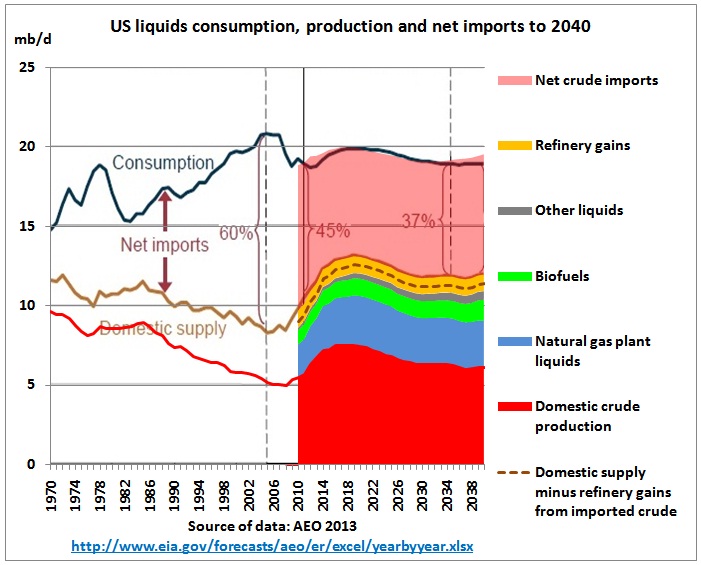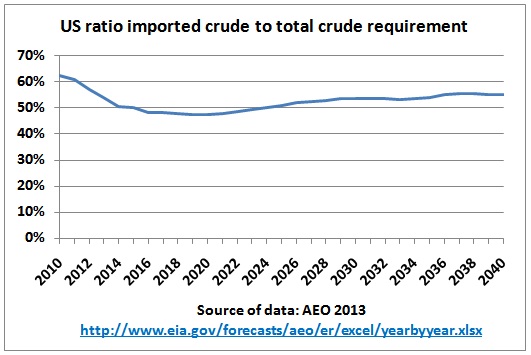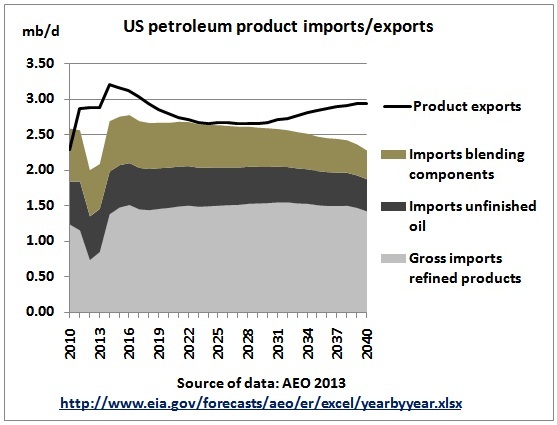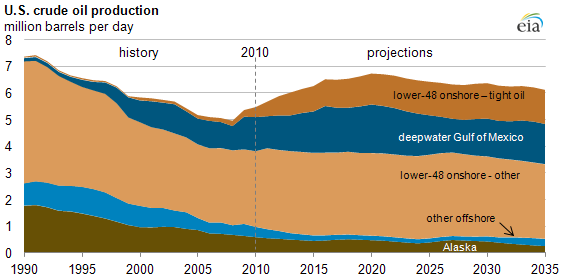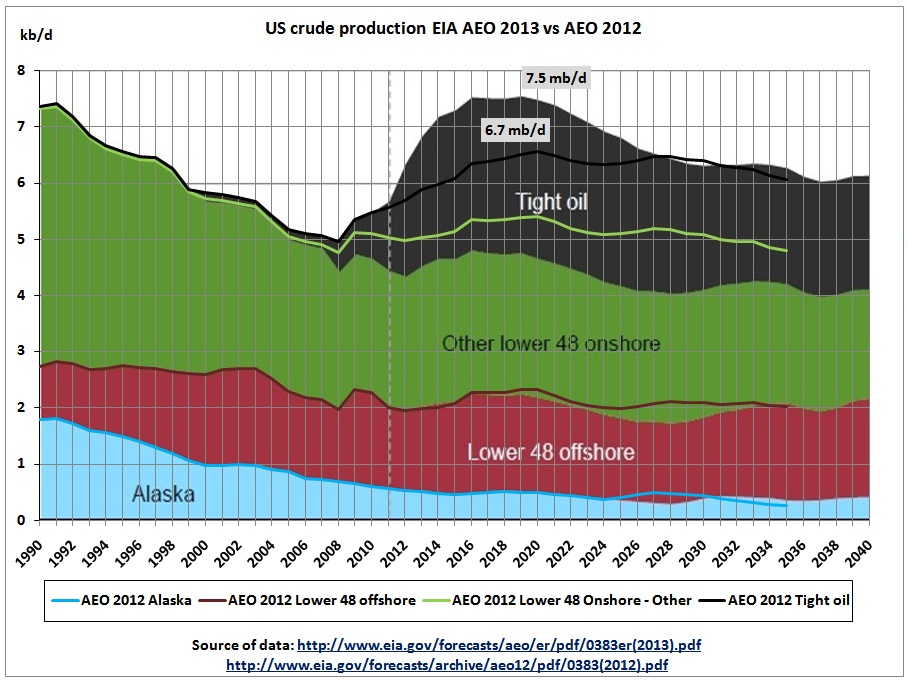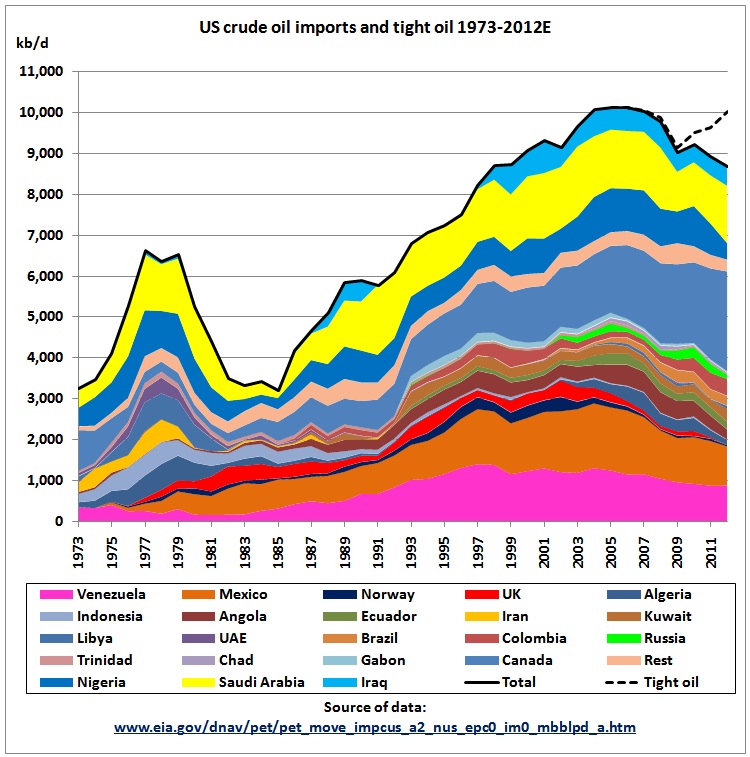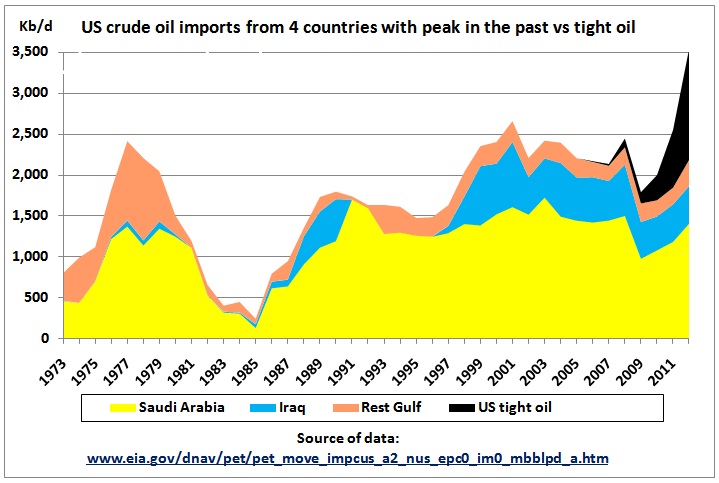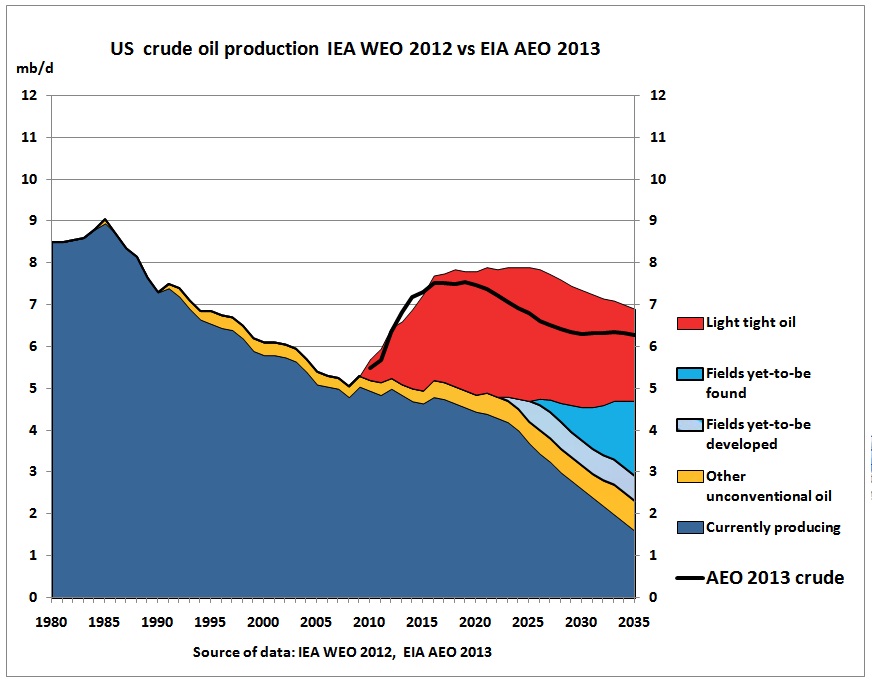This is an update to the previous article on US shale oil
Summary
The US based Energy Information Administration has increased its previous crude oil production forecast from 6.7 mb/d to 7.5 mb/d by the end of the decade. But the forecast of the Paris-based International Energy Agency of a long production plateau – published a month earlier – has not been confirmed as production is expected to decline after all shale oil sweet spots have been produced.
Dependence on crude oil imports will decline by just 10%, from 60% to 50%, belying media reports the US will become independent of imports. Expenditure for crude and liquid imports will fall slightly but then rise along with oil prices.
US crude imports have peaked in 2005 as a result of high oil prices and because of the peaking of oil production in Venezuela, Mexico, UK and Norway. Shale oil hasn’t even offset import declines from these 4 countries. Neither has shale oil replaced imports from the Middle East.
US all liquids consumption and supply
The EIA’s Annual Energy Outlook 2013 released on Dec 5th 2012, contained this graph:
http://www.eia.gov/forecasts/aeo/er/pdf/0383er(2013).pdf
showing that net imports of liquids will decrease from 45% of consumption in 2011 to 37% in 2040.
Crude oil
Let’s fill this graph with more detailed data available from an Excel file on the same website http://www.eia.gov/forecasts/aeo/er/tables_ref.cfm
The red line (actual) and red area (projected) represent the domestic crude oil supply. It peaked in 1970. The shale oil peak is NOT higher than the secondary Alaska peak (mid 80s). Natural gas plant liquids, bio fuels, other liquids and refinery processing gains are added to make up the total domestic supply (brown curve).
Note that around 60% of the processing gains are obtained from refining imported crude (albeit using domestic gas as hydrogen and energy input) so the real domestic supply is actually lower (brown dotted line). The difference between domestic supply and consumption is filled with imported crude oil (pink area). From the above graph it is easy to calculate the ratios of imported crude as a percentage of total crude requirements:
So the impact of shale oil is that this ratio goes down from 60% to 50%. No way the US will ever become independent of crude imports, not to mention becoming a net exporter of crude oil.
The small difference between the consumption line and the pink crude oil import area results from net imports/exports of other liquids.
Imports and exports of petroleum products are more or less balanced.
Comparison AEO 2012 and 2013
The AEO 2013 increased tight oil supply forecasts compared to the previous report
http://www.eia.gov/pressroom/presentations/sieminski_12052012.pdf
This was the 2012 version with a long production plateau:
Let’s see what has changed by superimposing these 2 graphs:
Lines depict the AEO 2012 version, areas are from Sieminski’s 2013 graph. We see that forecasts for Alaska and offshore haven’t changed much. Tight oil has been increased by 0.8 mb/d from 6.7 mb/d to 7.5 mb/d for the previous peak year 2020. The total amount of crude oil forecast to be produced more between 2012 and 2026 is around 4 Gb or +12%.
Note that around 500 – 800 kb/d of what was “other lower 48 onshore” have been “reclassified” to tight oil.
Let’s see what has changed in the all-liquids graph compared to the previous report:
(US refining capacity is projected to remain at 17.5 mb/d)
Production is brought forward in this decade but will go down below previous levels in the next decade. The amount of domestic supplies is the same in both cases, around 136 Gb for the period 2010-2040. This fast, early production is not very clever because oil will become ever more precious and expensive so it is better to produce slowly.
Expenditure for crude oil and product imports
The EIA has changed from WTI to Brent scenarios:
 Using the reference case they calculated the net expenditure (table 11) and this can be put into a graph:
Using the reference case they calculated the net expenditure (table 11) and this can be put into a graph:
Expenditure drops only temporarily in this decade, provided of course the oil price goes along the reference case. The IMF had calculated an oil price of $180 already for 2021. Whether our economy can survive this, is another question.
It seems that because of the expectation of another oil bonanza, consumption goes up a bit, but is calculated (via involuntary savings and/or fuel efficiencies) to go down later in the projection period in order to maintain similar net import levels as in the AEO 2012.
Peaking of crude imports
Let’s have a look at a timeline of crude oil imports and what role tight oil has played to reduce imports so far.
http://www.eia.gov/dnav/pet/pet_move_impcus_a2_nus_epc0_im0_mbblpd_a.htm
We see that crude imports have peaked in 2005, the year in which peak oil started and long before the tight oil increase took off. So it’s the high oil prices which initiated a declining trend in oil imports and not a replacement by tight oil. Tight oil is here defined as the incremental crude production of North Dakota and Texas since 2005.
We know that crude oil production has peaked in UK, Norway, Mexico and Venezuela so the peak in US imports from these countries was caused by these country peaks (lower part of the graph) and not by tight oil replacement.
Just to illustrate how tight oil compares to this decline:
 Up to now tight oil has not even offset the decline of these 4 countries, by volume. Note that US Gulf coast refineries are mainly designed for heavy Mexican and Venezuelan oil so it is not easy to compare different types of oil from different countries.
Up to now tight oil has not even offset the decline of these 4 countries, by volume. Note that US Gulf coast refineries are mainly designed for heavy Mexican and Venezuelan oil so it is not easy to compare different types of oil from different countries.
We can of course make any number of comparisons but this one should be interesting:
Crude imports from the Persian Gulf countries were NOT reduced, thus refuting the myth that tight oil made the US less dependent on the Middle East.
Comparison with IEA WEO 2012
And how about that IEA announcement in November 2012 on the fundamental shift in oil markets?
Let’s superimpose the EIA crude production curve on Fig 3.18 of the WEO 2012:
Oops. The Paris-based IEA has the shale oil increase on a much longer production plateau than the US based EIA (which should have more detailed data). The EIA writes in its AEO 2013 report:
After about 2020, production begins declining gradually to 6.1 million bpd in 2040 as producers develop sweet spots first and then move to less productive or less profitable drilling areas. (p1)
Conclusion
The earlier US shale oil bonanza spin spread by the IEA is now in the minds of thousands of planners and government officials. Preparations for future oil decline – already overdue – will be further delayed. The new EIA data tell a somehow different story but the damage has been done. And reality will be different yet again. Moreover, shale oil will neither stop armed conflicts in the Middle East impacting on oil supplies nor solve the budget problems in many countries where oil production has already peaked.
The reader of this article may judge whether all of the above constitutes an (oil-) energy revolution.
Related post
21/11/2012
US shale oil hype
http://crudeoilpeak.info/us-shale-oil-hype

